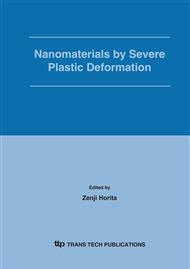p.711
p.717
p.721
p.727
p.733
p.739
p.745
p.751
p.757
Microstructure and Mechanical Properties Resulting from Cold Rolling of Equal Channel Angular Extruded Commercial Purity Copper
Abstract:
Equal channel angular extrusion (ECAE) is a processing method for introducing an ultrafine grain size into a material. In the present study, a two-step severe plastic deformation process was used to produce ultrafine grained copper with significantly enhanced strength. Equal channel angular extrusion was first used to refine the grain size of copper samples. The copper samples were further processed by cold rolling (CR) to a strain of 0.67 (about 50% reduction). This two-step process produced ultrafine grained copper with strengths higher than those of pure copper processed through ECAE only. This paper reports the microstructures and mechanical properties of the copper specimens processed by a combination of room temperature ECAE and CR. The effectiveness of initial processing by ECAE prior to cold rolling is discussed.
Info:
Periodical:
Pages:
733-738
Citation:
Online since:
January 2006
Authors:
Price:
Сopyright:
© 2006 Trans Tech Publications Ltd. All Rights Reserved
Share:
Citation:


